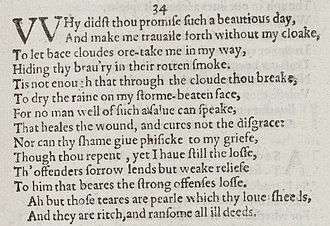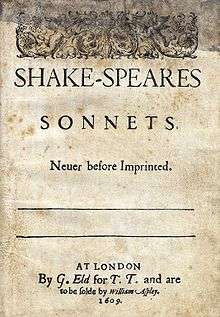Sonnet 34
| Sonnet 34 | |||||||
|---|---|---|---|---|---|---|---|
 Sonnet 34 in the 1609 Quarto | |||||||
|
| |||||||
| |||||||
Shakespeare's Sonnet 34 is a member of the Fair Youth sequence, and the second of a briefer sequence (Sonnet 33 through Sonnet 36) concerned with an unspecified sin committed against the speaker by a person the speaker loves.
Structure
Sonnet 34 is an English or Shakespearean sonnet, composed of three quatrains and a final couplet. It follows the form's typical rhyme scheme: abab cdcd efef gg. Like other Shakespearean sonnets, it is written in iambic pentameter, a type of poetic metre based on five pairs of metrically weak/strong syllabic positions. Line 12 exemplifies a regular iambic pentameter:
× / × / × / × / × / To him that bears the strong offence's cross. (34.12)
- / = ictus, a metrically strong syllabic position. × = nonictus.
It is possible that for Shakespeare the couplet embodied a true rhyme (as indicated by the Quarto spelling: sheeds/deeds) even though seemingly the singular shed would not have made a true rhyme with deed.[2]
Source and analysis
Following Horace Davis, Stephen Booth notes the similarity of this poem in theme and imagery to Sonnet 120. The quarto's "loss" was emended to "cross" by Edmond Malone and Edward Dowden; the emendation is now almost universally accepted. Gerald Massey finds an analogue to lines 7-8 in The Faerie Queene, 2.1.20.
The strong contrast between the first twelve lines and the couplet is often noted, but judged variously. The Christian overtones of "ransom," a word often used for Christian salvation, have been widely noted; for some structurally oriented critics, such as Booth and Joel Fineman, the couplet is notable for the way in which it echoes and transforms the metaphor of the opening line in a way that blurs the identity of lover and beloved.
Interpretations
- Robert Lindsay, for the 2002 compilation album, When Love Speaks (EMI Classics)
Notes
- ↑ Pooler, C[harles] Knox, ed. (1918). The Works of Shakespeare: Sonnets. The Arden Shakespeare [1st series]. London: Methuen & Company. OCLC 4770201.
- ↑ Booth, Stephen (2000) [1977]. Shakespeare's Sonnets. New Haven: Yale Nota Bene [Yale University Press]. p. 189. ISBN 0-300-08506-0.
References
- Baldwin, T. W. (1950). On the Literary Genetics of Shakspeare's Sonnets. University of Illinois Press, Urbana.
- Fineman, Joel (1984). Shakespeare's Perjur'd Eye: Representations. pp. 59–86.
- Hubler, Edwin (1952). The Sense of Shakespeare's Sonnets. Princeton University Press, Princeton.
- Schoenfeldt, Michael (2007). The Sonnets: The Cambridge Companion to Shakespeare's Poetry. Patrick Cheney, Cambridge University Press, Cambridge.
- First edition and facsimile
- Shakespeare, William (1609). Shake-speares Sonnets: Never Before Imprinted. London: Thomas Thorpe.
- Lee, Sidney, ed. (1905). Shakespeares Sonnets: Being a reproduction in facsimile of the first edition. Oxford: Clarendon Press. OCLC 458829162.
- Variorum editions
- Alden, Raymond Macdonald, ed. (1916). The Sonnets of Shakespeare. Boston: Houghton Mifflin Company. OCLC 234756.
- Rollins, Hyder Edward, ed. (1944). A New Variorum Edition of Shakespeare: The Sonnets [2 Volumes]. Philadelphia: J. B. Lippincott & Co. OCLC 6028485.
- Modern critical editions
- Atkins, Carl D., ed. (2007). Shakespeare's Sonnets: With Three Hundred Years of Commentary. Madison: Fairleigh Dickinson University Press. ISBN 978-0-8386-4163-7. OCLC 86090499.
- Booth, Stephen, ed. (2000) [1st ed. 1977]. Shakespeare's Sonnets (Rev. ed.). New Haven: Yale Nota Bene. ISBN 0-300-01959-9. OCLC 2968040.
- Burrow, Colin, ed. (2002). The Complete Sonnets and Poems. The Oxford Shakespeare. Oxford: Oxford University Press. ISBN 978-0192819338. OCLC 48532938.
- Duncan-Jones, Katherine, ed. (2010) [1st ed. 1997]. Shakespeare's Sonnets. The Arden Shakespeare, Third Series (Rev. ed.). London: Bloomsbury. ISBN 978-1-4080-1797-5. OCLC 755065951.
- Evans, G. Blakemore, ed. (1996). The Sonnets. The New Cambridge Shakespeare. Cambridge: Cambridge University Press. ISBN 978-0521294034. OCLC 32272082.
- Kerrigan, John, ed. (1995) [1st ed. 1986]. The Sonnets ; and, A Lover's Complaint. New Penguin Shakespeare (Rev. ed.). Penguin Books. ISBN 0-14-070732-8. OCLC 15018446.
- Mowat, Barbara A.; Werstine, Paul, eds. (2006). Shakespeare's Sonnets & Poems. Folger Shakespeare Library. New York: Washington Square Press. ISBN 978-0743273282. OCLC 64594469.
- Orgel, Stephen, ed. (2001). The Sonnets. The Pelican Shakespeare (Rev. ed.). New York: Penguin Books. ISBN 978-0140714531. OCLC 46683809.
- Vendler, Helen, ed. (1997). The Art of Shakespeare's Sonnets. Cambridge, MA: The Belknap Press of Harvard University Press. ISBN 0-674-63712-7. OCLC 36806589.
External links
 Works related to Sonnet 34 at Wikisource
Works related to Sonnet 34 at Wikisource- Paraphrase and analysis (Shakespeare-online)
- Analysis
.png)
